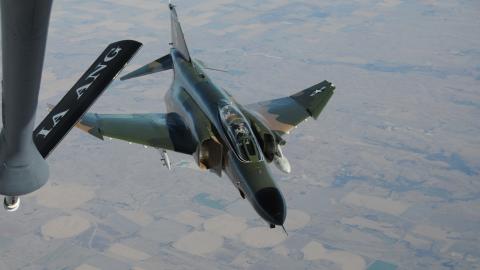It’s rightly been called the airlift that saved Israel.
And an airlift that interrupted my English history professor’s lectures.
On Oct. 6, 1973, at 2 o’clock in the afternoon, Israel was attacked by the Soviet-backed forces of Egypt and Syria. The surprise attack put Israel on the brink of collapse.
But within the first few days of the Yom Kippur War, Israel Defense Forces counterattacked and took the offensive — and, in doing so, ran dangerously low on ammunition, tanks, and aircraft.
Israeli Prime Minister Golda Meir phoned President Richard Nixon on Oct. 9 asking for assistance. Nixon immediately obliged.
But for the next three days, the U.S. bureaucracy dithered on whether and how to resupply Israel.
In his masterful account The Two O’Clock War: The 1973 Yom Kippur Conflict and the Airlift that Saved Israel(2002), the late U.S. Air Force Col. Walter J. Boyne attributed the dithering to bureaucratic infighting, fear of an Arab oil embargo, and maintaining détente with the Soviet Union.
By Oct. 12, Nixon had finally had enough. He tersely ordered the Pentagon to “send everything that can fly.”
That simple, concise order broke the logjam. “Like a racehorse released from the gate,” Boyne wrote, “the USAF began to assemble all the manifold bits and pieces required to funnel supplies from all over the world” to Israel. Operation Nickel Glass was finally underway.
And none too soon. As Boyne recounts, by the time Nixon gave the order, Israel had less than a two-week supply of ammunition. By the time the first massive cargo aircraft arrived in Israel, the IDF had munitions for a week.
I was reminded of Nickel Glass at a reunion last month at the Citadel in Charleston, South Carolina. Our reunion coincided with the 50th anniversary of the airlift.
Capers Hall housed the English, history, and political science departments for generations of Citadel cadets. It also lay in the departure flight path for Charleston Air Force Base, one of three east coast bases serving as Israel’s lifeline.
For weeks, massive C-141 Starlifter and C-5 Galaxy fully loaded cargo planes roared over the campus, lumbering at full thrust to gain altitude. The noise rattled the windows in Capers Hall — and interrupted professor Charles Martin’s lectures.
Martin, who died in 1999 at 80, was a self-described anglophile and a brilliant English history professor. He laced his lectures with amusing anecdotes no doubt designed to keep our sleep-starved brains awake. And he was a staunch supporter of Israel.
We adolescent cadets assigned humorous and sometimes indelicate nicknames to our professors. Martin’s roly-poly physique and good-natured manner earned him the sobriquet “Fat Jack.” Steppenwolf’s 1970 hit no doubt played a role in the assignation.
His Battle of Agincourt lecture was legendary. He gleefully recounted every detail. He found King Henry V’s use of the powerful English longbow especially satisfying. The French were surprised, engaged, and ultimately slaughtered beyond their range of vision and retaliation.
This gleeful lecture roused the pique of Cadet Jack Lapierre – Frenchy, of course – who posed the rather snide observation that it was cowardly of Henry not to engage the French in close quarter combat.
The retort was classic Fat Jack. Hiking up his uniform trousers, he shot back, “Mr. Lapierre, why grapple with a pig when you can kill him with a stick.” His antipathy for everything French knew no bounds.
Agincourt was his prized lecture. It had a flow and rhythm bordering on musical. Interruptions threw him off kilter. And the aircraft noise was especially disruptive.
So, it was no surprise when he turned to my classmate Cadet Wayne Goldstein — proud member of our campus Hillel — with a wry smile and said, “You might tell them, Mr. Goldstein, to hold off during my lecture.” While said in jest, perhaps he harbored hope Wayne had a direct line to the Military Airlift Command.
Well, they didn’t hold off, and for 32 days — from Oct. 13 to Nov. 14 — the U.S. Air Force flew 567 missions delivering over 22,000 tons of material to Israel. A stunning achievement.
Packed inside these massive aircraft were howitzers, cannons, M-60 and M-48 battle tanks, CH-53 helicopters, and disassembled A-4 Skyhawk aircraft. And tons and tons of ammunition. An additional 48 F-4 Phantom II fighters and 26 A-4 Skyhawks were refueled inflight to Israel.
“For generations to come,” Golda Meir proclaimed, “all will be told of the miracle of the immense planes from the United States bringing in the material that meant life for our people.”
America stood tall with Israel then. Let’s hope we stand just as tall with Israel today.
And Fat Jack still looms large in the now aging minds of Frenchy, Wayne, and me.



















